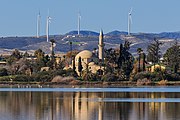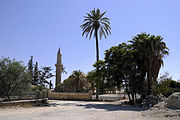Hala Sultan Tekkesi
 | |
 | |
| Temel bilgiler | |
|---|---|
| Konum | |
| Koordinatlar | 34°53′07″K 33°36′36″D / 34.88528°K 33.61000°D |
| İnanç | İslam |
| Mimari | |
| Tamamlanma | 647-649 |
Hala Sultan Tekkesi Kıbrıs'ın en ünlü tekkesidir. Larnaka'da Tuz Gölü yakınlarında bulunan, Kıbrıs'ın yedinci ve onuncu yüzyıllar arasında Emevi halife Muaviye'nin gönderdiği İslam askerlerince adaya düzenlenen seferler sırasında Muhammed peygamberin halası ve süt annesi olan Hala Sultan’ın (Ümmü Hiram ya da Ümmühan) vefat ettiği noktada, M. 647-649 yılları arasında inşa edilmiştir.
Osmanlı İmparatorluğu döneminde, özellikle 18. yüzyıldan itibaren padişah ve kıdemli devlet erkanı tarafından bakım ve onarımı üstlenerek, eklenen yapılarla bir külliyeye dönüştürülmüş olup, tekke şeklinde anılmaya devam etmektedir. Birleşmiş Milletler ve diğer bağışlarla Tekkenin islahatı yakın dönemde tamamlanmıştır.
Türbeyle ilgili, üzerinde havada asılı duran siyah bir göktaşı efsanesi vardır.
Önemi
[değiştir | kaynağı değiştir]Kıbrıs Türk Müslümanları tarafından kutsal bir yer olarak tanılan cami,[1][2][3] bütün Müslümanlar tarafından da, çağdaş laik kaynaklara göre, saygıdeğer olarak tanınmaktadır.[4][5][6][7] Kıbrıs'ın çevre ve kültürel zenginlikleri ile ilgili bir değerlendirmede, Tennessee Üniversitesinde kıdemli Fulbright bilgini olan Profesör George E. Bowen, alıntısında Hala Sultan Tekke'sine Müslümanlar için dünyanın üçüncü en kutsal yeri olarak hitap etmiştir.[8] Kıbrıs'taki Birleşmiş Milletler Kalkınma Programı[9] ve Kıbrıs idaresinin Antikalar Dairesi dahil,[10] bu görüş başkalarınca da tekrarlanmıştır.[11][12][13][14] Diğerlerince dördüncü en kutsal yer olarak tanımlanır.[15][16][17] Mevkiin bölünmüş adanın Rum gayri-Müslim tarafında kalması sonucu, mevkiye ziyaretler çok yoğun değildir.[18]
Osmanlı döneminde, Larnaka sahillerinden geçen Osmanlı bayraklı gemiler bayraklarını yarıya indirip, Hala Sultan'ı selamlamak için top ateş ederlerdi.[19]
Galeri
[değiştir | kaynağı değiştir]-
Önplanda Tuz Gölü olan Hala Sultan Tekkesi
-
Kış mevsiminde havadan Tuz Gölü ve Hala Sultan Tekkesi fotoğrafı
-
Hurma ve Palmiye ağaçları arasında Hala Sultan Tekkesi
-
Hala Sultan Camii içi
Kaynakça
[değiştir | kaynağı değiştir]- ^ Boyle, Kevin; Juliet Sheen (Ekim 1997). "Cyprus". Freedom of religion and belief: a world report. Londra: Routledge. ss. 286-293. ISBN 0-415-15977-6. LCCN 97224015. 17 Mayıs 2016 tarihinde kaynağından arşivlendi. Erişim tarihi: 18 Şubat 2015.
The tomb is said to be revered by Turkish Cypriots as the 'third holiest site in Islam'
- ^ "Study of building stones and mortar from Hala Sultan Tekke mosque". Hellenic Society for Archaeometry. 16 Mayıs 2003. 17 Eylül 2008 tarihinde kaynağından arşivlendi. Erişim tarihi: 19 Haziran 2007.
Hala Sultan Tekke, near Larnaka, is a holy site in Islam and the most important one for Cypriot Muslims.
- ^ Financed Restoration of Church and Mosque on Cyprus Supports Cultural Heritage and Tolerance 13 Şubat 2009 tarihinde Wayback Machine sitesinde arşivlendi., USAID Press Office, July 5, 2002. "Hala Sultan Tekke, one of the holiest sites in Islam, is the most important religious location for Cypriot Muslims."
- ^ Purcell, Hugh Dominic (1969). Cyprus. Praeger. s. 367.
At the end of 1965, the National Guard had taken over the shrine of Hala Sultan Tekke, a place of small strategic importance. From May 1966 they prevented all Moslem access to it, so that Mehmet Dana, Mufti of Cyprus, could exploit the misuse of one of the holiest places in the world of Islam.
- ^ Syneleusis, Hellēnikē Koinotikē; Hypourgeio Paideias; Grapheion Dēmosiōn Plērophoriōn (1963). Cyprus Today. Public Information Office, Cyprus. s. 16. 18 Şubat 2015 tarihinde kaynağından arşivlendi. Erişim tarihi: 18 Şubat 2015.
As such, it is one of the holiest sites in Islam and the most important religious location for Turkish Cypriots and other Muslims living in Cyprus.
- ^ J magazine 20 Şubat 2012 tarihinde Wayback Machine sitesinde arşivlendi. (Inflight magazine for Jazeera Airways), Ink Publishing, 2008. Retrieved: 23-02-2009: "Hala Sultan Tekke (or Mosque of Umm Haram)...is one of Islam's holiest sites."
- ^ "Egyptian professor to renovate ancient mosque of Hala Sultan". Arabic News. 30 Temmuz 2002. 14 Şubat 2012 tarihinde kaynağından arşivlendi. Erişim tarihi: 15 Mart 2009.
One of the most revered sites of Islam.
- ^ Bowen, George E. (3 Nisan 2001). "Assessing the Isle of Cyprus". Patrick S. O'Brien on the University of Tennessee server. 23 Ağustos 2013 tarihinde kaynağından arşivlendi. Erişim tarihi: 12 Kasım 2006.
Three historic churches and monasteries are within the city. Just outside the city is the location of the Hala Sultan Tekke Mosque, the third holiest place for Muslims in the world.
- ^ "Hala Sultan Tekke: Where East Meets West". Issue 1. United Nations Development Programme. Bahar 2006. 28 Eylül 2007 tarihinde kaynağından arşivlendi. Erişim tarihi: 12 Kasım 2006.
Islam's third sacred holy site after the Ka'ba and the Prophet Mohammad's grave in Mecca, and among the greatest cultural heritage monuments of the world, Hala Sultan Tekke, or Umm Haram, has long been the destination of Muslim pilgrims from Cyprus and the Middle East.
- ^ "Monuments: Hala Sultan Tekke". Republic of Cyprus, Ministry of Communications and Works; Department of Antiquities. 2005. 10 Temmuz 2015 tarihinde kaynağından arşivlendi. Erişim tarihi: 6 Mart 2006.
The Muslim mosque of Hala Sultan is located in the center of a spectacular garden at the west bank of the Salt Lake, about 6 km southwest of Larnaca. It is the main Muslim pilgrimage site of Cyprus and the third most important holy place of Islam.
- ^ Drayton, Penny (Ocak 1993). "Aphrodite's island". Wood & water. 2 (41). Cited by: Trubshaw, Bob (Şubat 1993). "The Black Stone - the Omphalos of the Goddess". Mercian Mysteries, 14. 8 Aralık 2006 tarihinde kaynağından arşivlendi. Erişim tarihi: 12 Kasım 2006.
In Cyprus is another highly venerated Islamic site - the third most important after Mecca and Medina - the Hala Sultan Tekke. This, too, has a black rock, said to have fallen as a meteorite as part of the tritholon over the shrine. The shrine is to a woman - the aunt and foster mother of Prophet Mohammed
- ^ Daniel, Geoff; John Oldfield; Christine Oldfield (2004). Landscapes of Cyprus. Sunflower. s. 36. ISBN 1-85691-229-9.
- ^ The Story of Hala Sultan Tekke 5 Mart 2009 tarihinde Wayback Machine sitesinde arşivlendi., University of Arizona: Center for Middle Eastern Studies, "The Mosque of Umm Haram is the chief Muslim shrine on the island of Cyprus and an important holy site for the entire Muslim world... The Hala Sultan Tekke is the third most revered site of pilgrimage in the Muslim world." Retrieved: 23-02-2009
- ^ Papalexandrou, Nassos. Hala Sultan Tekke, Cyprus: An Elusive Landscape of Sacredness in a Liminal Context 3 Mart 2016 tarihinde Wayback Machine sitesinde arşivlendi., Journal of Modern Greek Studies, Volume 26, Number 2. Johns Hopkins University Press, (October 2008) pp. 251-281. "Der Parthog calls it the "third most holy space in Islam" (1995:222–223)"
- ^ Khatchatourian, Khadijah Tara. (2006) Hala Sultan Tekke[ölü/kırık bağlantı], Spohr Publishers, "The Hala Sultan Tekke is fourth in importance to the Muslim world". Retrieved: 23-02-2009
- ^ "The Cultural Heritage of Cyprus: Part XIII. The Shrine of Hala Sultan Tekke" (PDF). The Blue Beret. pg.5. Public Information Office of the United Nations Peacekeeping Force in Cyprus. Haziran 2003. 26 Ağustos 2012 tarihinde kaynağından (PDF) arşivlendi. Erişim tarihi: 6 Mart 2006.
Not just the holiest Muslim shrine in Cyprus, Hala Sultan Tekke is one of the holiest shrines in the Islamic world, after Mecca, Medina, and Jerusalem.
- ^ Galatariotou, Catia (2004). The Making of a Saint. Cambridge University Press. s. 62. ISBN 0-521-39035-4. 18 Şubat 2015 tarihinde kaynağından arşivlendi. Erişim tarihi: 18 Şubat 2015.
It is also worth remembering that the tekke of Um-Harram (Hala Sultan tekke) near Larnaka was one of the holy places which every Muslim was expected to visit as a pilgrim, ranking only fourth in importance after Mecca, Medina and Jerusalem
- ^ Worpole, Ken; Larraine Worpole (2003). Last Landscapes. Reaktion Books. s. 42. ISBN 1-86189-161-X.
- ^ Charalambous, Charlie (20 Aralık 2005). "Restored Mosque Brings Hope for Cyprus Ethnic Divide". Arab News. 18 Şubat 2015 tarihinde kaynağından arşivlendi. Erişim tarihi: 13 Eylül 2007.



